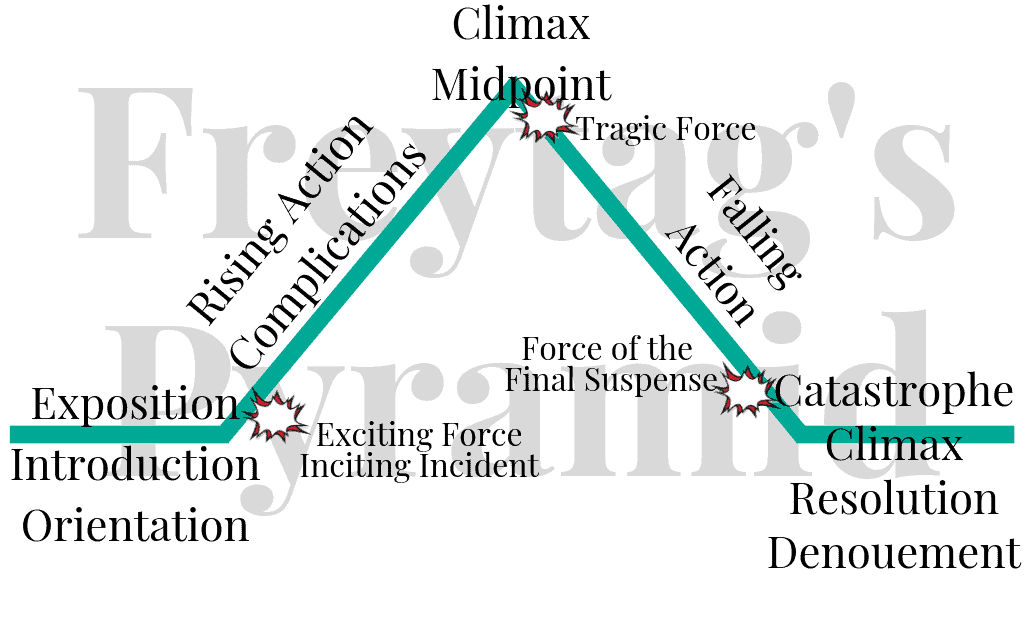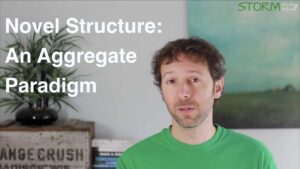You’ve come across it somewhere. Perhaps in a high school English class. Perhaps in some craft article you stumbled upon online. If you Google “plot diagram,” it’s literally the first thing that appears in the search: the famous Freytag’s pyramid.
It looks like this:

But people sometimes make it look like this:

I’d like to straighten some things out.
The Pyramid
Gustav Freytag is the Freytag in question, and he wrote a book called Technique of the Drama, an academic treatise on techniques involved in playwriting. The famous pyramid appears in the book as this:

He does, indeed, call it a pyramid (or at least the translation calls it a pyramid), for reasons I can’t figure out. It’s not three dimensional. But it is a symmetrical triangle, not the lopsided one. Freytag’s labels (translated) are a) introduction, b) rise, c) climax, d) fall or return, and e) catastrophe.
But you’ll often see them labeled a) exposition, b) rising action, c) climax, d) falling action, and e) resolution.
For most of my life, I’ve hated the pyramid. Especially when I taught high school and witnessed teachers and students alike try to wrest stories into the pyramid’s shape with nary an ounce of enlightment being squeezed from their carefully constructed Prezis and PowerPoints.
Sure, an introduction and rising action make sense. But my biggest complaint has always been about the climax, which, as we all know, happens near the end of any given story. So this whole business of falling action and resolution always seemed to me to be far too much to tack on. Why pay so much attention to the 2-5% of the story to follow the climax?
The “Climax”
Ah, but Freytag’s climax is not the climax. At least, that’s not the word we would use nowadays for what he terms the climax. The word we would use nowadays is the midpoint.
Freytag identifies the banquet scene in Macbeth—that moment when the ghost of Banquo shows up and wreaks havoc on Macbeth’s conscience and Macbeth begins to fear that he’s headed for doom as he utters the famous line, “It will have blood; they say, blood will have blood.”
In Othello, it’s when Iago arouses Othello’s jealousy.
In Romeo and Juliet, it’s when Romeo is forced to kill Tybalt and has to flee.
In all of these cases, Freytag is identifying the scene at the literal center of the play—like scene 12 of 24 in Romeo and Juliet, for instance.
What happens at Freytag’s climax?
Freytag describes the “climax” as including an “outburst of deed from the soul of the hero, or the influx of portentous impressions into the soul; the first great result of a sublime struggle, or the beginning of a mortal inward conflict.”
Compare that to James Scott Bell’s explanation of the midpoint:
At this point in the story, the character looks at himself. He takes stock of where he is in the conflict and––depending on the type of story––has either of two basic thoughts. In a character-driven story, he looks at himself and wonders what kind of person he is. What is he becoming? In plot-driven fiction, the character looks at himself and considers the odds against him. At this point the forces seem so vast that there is virtually no way to go on and not face certain death. That death can be physical, professional, or psychological.
The midpoint is always an enormous turn within the story that spurs a downward trajectory—particularly in a tragedy, which is the source of most of Freytag’s examples.
Some modern examples: the Titanic sinks, an alien bursts from a crew member’s stomach, a T-Rex loose from its electrified enclosure attacks, Harry discovers the trapdoor to the sorcerer’s stone.
I think of it like this: for Freytag, the “climax” isn’t the ultimate battle with the forces of antagonism. Instead, it’s the “shit just got real” moment.
Falling Action
Freytag’s fall or return is what follows next. It happens after what he calls the climax and before what we call the climax. In other words, it’s what comes between the midpoint and the climactic point of the story in our modern-day phrasing. After the “shit got real” moment, the protagonist is headed toward an all-is-lost moment, which then leads into a climactic face-off. So there’s a falling quality to it. Things are getting tougher, more challening.
The appearance of Banquo’s ghost (midpoint) leads to Macbeth losing all his sanity and support (falling action) prior to his face-off with Macduff (climax). As a result of his murder of Tybalt, Romeo has to be apart from Juliet and then believes he’s lost her, which then leads to the climactic double suicide. Othello gradually turns against Desdemona until the climactic moment of Iago’s exposure.
The fall or return is simply the character’s plummeting fortune or escalating moral failure or accumulating setbacks as the hero moves towards the climax. Freytag’s conceptualization of a story is that in the first half, things go pretty well for the hero; in the second half, things don’t go well.
In all of these cases, Freytag’s language for the actual climactic moment makes sense: the catastrophe.
Catastrophe
Allow me to quote from Freytag once again:
The catastrophe of the drama is the closing action . . . . In it the embarrassment of the chief characters is relieved through a great deed. The more profound the strife which has gone forward in the hero’s soul, the more noble its purpose has been, so much more logical will the destruction of the succumbing hero be.
Two observations here.
First, you can see that Freytag was mostly dissecting tragedy. So much of his language is about the tragic ending, including the word “catastrophe” itself. But add to the list embarrassment, destruction, and succumbing.
Second, if you’ve seen this final stage labeled the resolution or denoument, it’s because Freytag really makes no distinction between climax and resolution. They occur in quite rapid succession, especially in a tragedy.
Freytag’s Forces
In addition to his five acts, Freytag posits three transition points: the exciting force, the tragic force, and the force of the final suspense.
The exciting force is simply the inciting incident.
The tragic force occurs at the climax or right afterwards, “when at a certain point in the action, there enters suddenly, unexpectedly, in contrast with what has preceded, something sad, somber, frightful” and kicks off the fall of the hero.
The force of the final suspense is a “new, slight suspense; a slight hindrance, a distant possibility of a happy release, is thrown in the way of the already indicated direction of the end.” For a tragedy, it is a final moment of hope that the hero might escape the tragic catastrophe. In stories of triumph, which are much more popular nowadays, this final suspense comes in the form of an all-is-lost moment, which, acting as a sort of inverse to the tragic plot’s hope for “happy release” is instead a fear of unhappy constriction.
Modern Paradigms vs. Freytag
If we take Freytag’s language literally and fail to read his explanations for his various stages, then the pyramid is worse than useless; it’s just an incorrect assessment of how stories are structured—now or 500 years ago. But if we apply some translation, we can see that Freytag isn’t all that off from modern-day structural paradigms.
In fact, here’s a little side-by-side for you:

Freytag may actually be more helpful for our construction of the middle than many modern paradigms are, seeing as these recent paradigms often leave the middle in the lurch.
Indeed, I’d say Freytag’s great contribution for modern storytellers is the emphasis on the midpoint’s importance and his clear distinctions between the two halves of the story.
We’ve seen a wide array of stories since Freytag, and certainly not all of them chart well along the first half = success/ second half = failure paradigm common to most tragedies. But there are other dichotomies writers can explore: passive/active, doubtful/committed, desire/need, facade/essence, etc.
In his opening chapter to Damn Fine Story, Chuck Wendig calls Freytag’s Pyramid “bullshit,” and ultimately I don’t disagree with his assessment that no story conforms to a standard shape, especially a two-dimensional shape that will inevitably be too simplistic. But I do believe that Freytag is maybe less bullshit than we’ve all made him out to be.
For more on structure, see these posts:
For more on Freytag’s Pyramid, also see this illuminating article from The Novel Factory.









One Response
The climax point was always a problem for me during high school English…missed it every time. During a drama class at university, I learned about the major dramatic question and the dramatic climax. Finally story structure made sense. The point if commitment my English teachers called THE climax is the structural climax. The point I sensed where there was nowhere left to go (and always called the climax, getting the teacher’s big red X) is the dramatic climax. The major dramatic question is the single question riding threw the entire plot that when answered (what my teachers called the main idea) signals the end of the story. I taught high school English this way and students understood: TWO types of climaxes and a major dramatic question. You are the first person outside of my drama courses to also say this. Thanks.